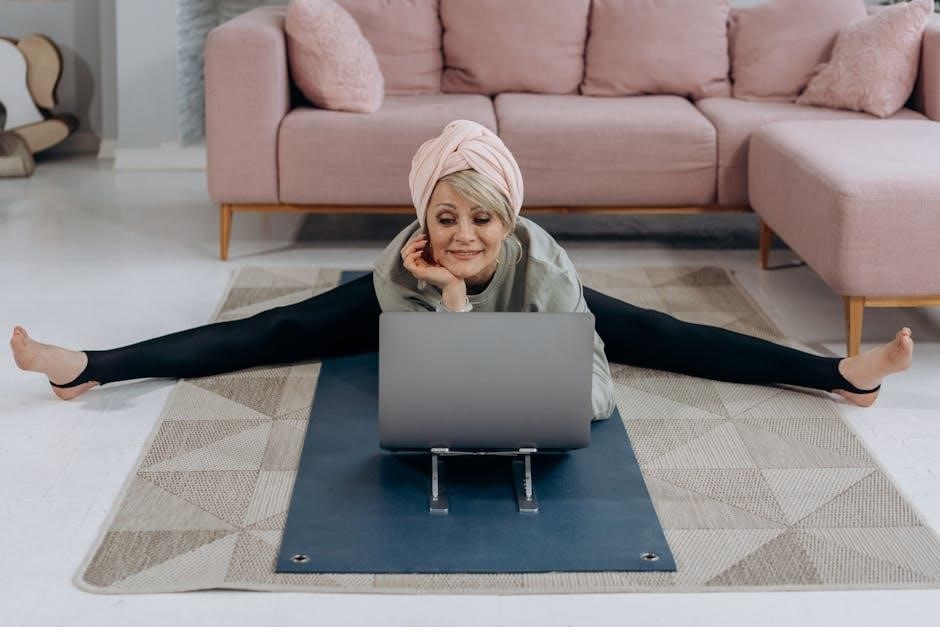Regular stretching exercises can help office workers reduce muscle tension and improve overall health, using simple techniques like wrist and finger stretches, as part of a daily routine, with p tags for formatting purposes only.
Importance of Stretching for Office Workers
Stretching exercises are essential for office workers as they spend most of their time sitting at their desks, which can lead to muscle tension and decreased productivity. Regular stretching can help improve blood circulation, reduce eye strain, and prevent musculoskeletal disorders. Office workers who stretch regularly are less likely to experience back and neck pain, and are more likely to have better posture and reduced stress levels. Additionally, stretching can help improve focus and concentration, leading to increased productivity and better work performance. By incorporating stretching exercises into their daily routine, office workers can experience numerous physical and mental health benefits, leading to a healthier and more productive work life. With the use of simple stretching techniques, office workers can reduce the risk of injury and improve their overall well-being, making it an essential part of their daily routine, using p tags for formatting purposes only, with regular exercise.

Benefits of Stretching Exercises
Stretching exercises improve flexibility, reduce muscle tension, and increase energy levels, with regular practice, using p tags for formatting purposes, enhancing overall health and well-being slowly.
Preventing Injuries and Improving Productivity
Regular stretching exercises can help prevent injuries and improve productivity in the workplace, by reducing muscle fatigue and improving circulation, using techniques such as wrist and finger stretches, and shoulder rolls, to loosen tight muscles.
By incorporating stretching exercises into their daily routine, office workers can reduce their risk of injury, and improve their overall health and well-being, which can lead to increased productivity and job satisfaction, and reduced absenteeism.
Additionally, stretching exercises can help to reduce eye strain, and improve posture, which can help to prevent long-term damage, and improve overall health, and can be done at a desk, or in a break room, making it easy to incorporate into a busy schedule, with minimal equipment or space required, and can be adapted to suit different fitness levels, and abilities, making it accessible to everyone.

Types of Stretching Exercises for Office Workers
Office workers can benefit from various stretches, including neck, shoulder, and wrist exercises, to improve flexibility and reduce tension, using simple techniques, with p tags for formatting purposes only always.
Neck and Shoulder Stretches
Neck and shoulder stretches are essential for office workers, as they help reduce muscle tension and improve posture. These stretches can be done at your desk, taking only a few minutes to complete. To stretch your neck, slowly tilt your head to the side, bringing your ear towards your shoulder, and hold for 15 seconds. Then, roll your shoulders forward and backward in a circular motion, repeating for 10 repetitions. You can also place your hands behind your back and interlock your fingers, pulling your shoulders back and opening up your chest. This stretch helps to improve your posture and reduce shoulder tension. Additionally, you can try shoulder rolls, where you roll your shoulders forward and backward in a circular motion, helping to loosen up tight muscles. By incorporating these neck and shoulder stretches into your daily routine, you can help reduce muscle tension and improve your overall comfort and productivity at work, using simple techniques and p tags for formatting purposes only always.

How to Perform Stretching Exercises
Slowly move into stretches, holding each for 15 seconds, using p tags and proper technique to avoid injury and get maximum benefits from exercises always daily.
Proper Technique and Safety Precautions
When performing stretching exercises, it is essential to use proper technique and follow safety precautions to avoid injury and get the most out of the exercises. This includes slowly moving into stretches, holding each for 15 seconds, and avoiding bouncing or jerking movements. It is also important to listen to your body and stop if you experience any pain or discomfort. Additionally, it is recommended to stretch after a warm-up or light physical activity, and to focus on major muscle groups. Using p tags and proper technique can help prevent injury and ensure a safe and effective stretching routine. Furthermore, it is crucial to be mindful of your surroundings and ensure you have enough space to perform the stretches without obstruction. By following these guidelines and using proper technique, you can help prevent injuries and improve your overall health and well-being. Proper technique is key to a successful stretching routine.

Creating a Stretching Routine for Office Workers
Office workers can create a routine with simple exercises, using p tags, to improve health and reduce tension, with regular practice and consistency, for overall well-being, every day, at work.
Sample Stretching Exercises and Schedules
Office workers can follow a sample stretching schedule, using exercises like wrist and finger stretches, to improve overall health and reduce muscle tension, with regular practice and consistency, for overall well-being, every day, at work, using p tags for formatting purposes.
Exercises can be done in short intervals, like 5-10 minutes, with focus on major muscle groups, and can be customized to fit individual needs and schedules, using online resources and PDF guides, for easy reference and accessibility, at home or in the office, with minimal equipment and space required, making it easy to incorporate into daily routine, and improve overall health and productivity, with consistent practice and dedication, and can be adjusted to suit different fitness levels and goals, using various exercises and techniques, and can be combined with other wellness activities, like meditation and deep breathing, for enhanced benefits, and can be done with colleagues or friends, for motivation and support, and can be tracked and monitored, using journals or mobile apps, for progress and accountability.



